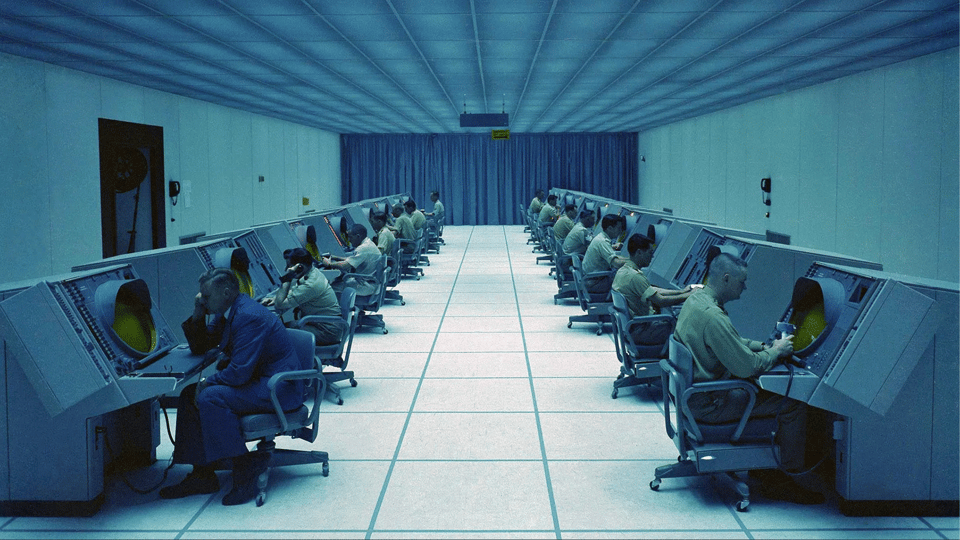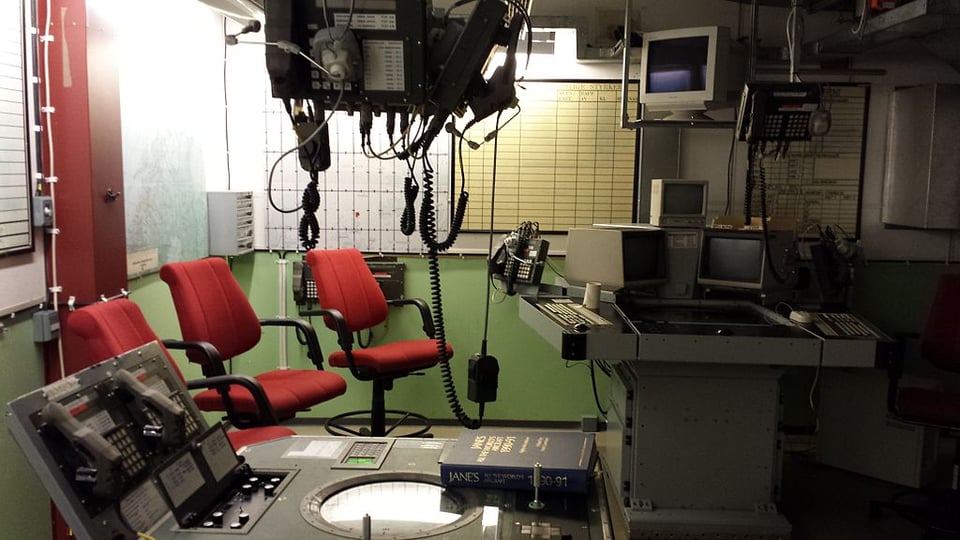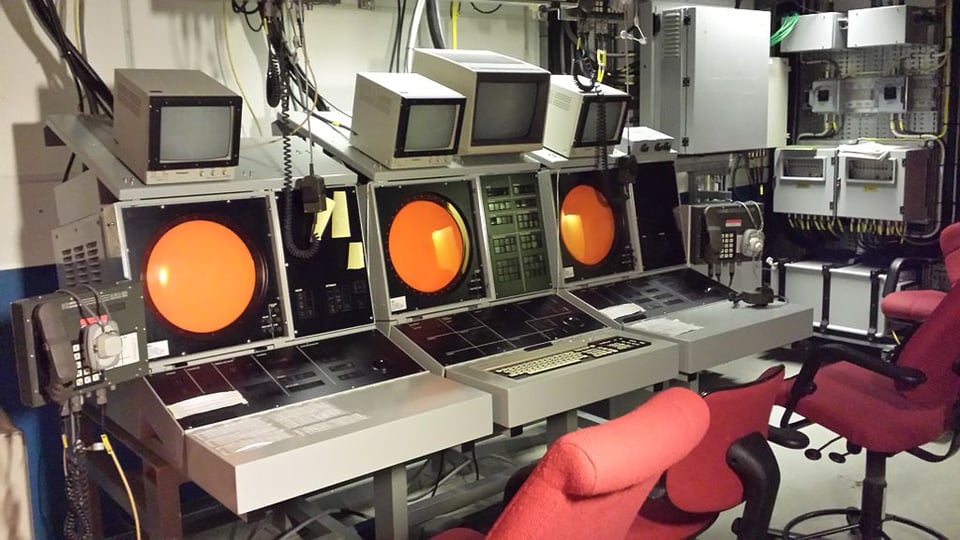dispatch 006 - rationalized logistics and the NATO knowledge enterprise
a genealogical analysis connecting the historical development of Cold War-era military user interfaces with the contemporary knowledge management systems of the North Atlantic Treaty Organization (NATO)
✦ This Haunted Inbox Where I Archive ✦
A drawer inside the cathedral. Fragments drift through. You may linger, but some things will not be explained.

A Genealogical Analysis of Military Control Logic in Contemporary Knowledge Representation Systems
Here I am attempting a genealogical analysis connecting the historical development of Cold War-era military user interfaces with the contemporary knowledge management systems of the North Atlantic Treaty Organization (NATO). For the past couple of months I’ve been researching the Military Origins of UI/UX Design as part of my current work on "Affective Logistics". During this research I came across a relatively recent NATO Science and Technology Organization report, "Knowledge Representation and Reasoning" (STO-TR-IST-ET-111), and I thought it could serve as a critical case study. I would argue that NATO's current approach to knowledge management represents a direct continuation and sophistication of the control logic forged in mid-20th century command centers. This contemporary paradigm, which I’d provisionally call Rationalized Logistics (perhaps as an adjacent model to Just-in-time logistics), operates through the systematic abstraction of language to route human affect toward a state of detached operational efficiency, producing a maximally efficient human-machine analytical apparatus. This stands in contrast to the consumer-facing paradigm of Affective Logistics, which operates through the simulation of affect to capture emotional investment.
The Logics of Algorithmic Governance
I have already mentioned in previous dispatches of this newsletter that I see contemporary algorithmic governance emerging from several distinct, yet related, historical logics of control: one developed in military command rooms, the other in the optimized domestic sphere and yet another on the factory floor (Taylorism, Toyota’s just in time logistics etc).
Today I am interested in further excavating the genealogy of the first of these logics: the military command room through NATO technical report on Knowledge Representation and Reasoning (KRR) as a direct descendant of the human-computer interaction (HCI) models developed during the Cold War. My central thesis is that the NATO KRR system exemplifies a contemporary military paradigm of Rationalized Logistics. This paradigm does not seek to capture or simulate affect, but to systematically engineer it out of the cognitive loop through the formal abstraction of language and data.

Genealogical Precedent: The Cold War Interface and Affective Suppression
The groundwork laid by Cold War military imperatives was the foundational principles of modern HCI. Systems like the Semi-Automatic Ground Environment (SAGE) were not merely technical achievements; they embodied a specific philosophy of control. I am not going to overextend my analysis here but there are some key tenets worth noting, namely, the Cybernetic Model where the human operator was conceived not as an autonomous subject but as an integral component in a closed feedback loop (I’d perhaps see the operator in this context as a regulatory node whose function was to process information and execute commands with maximum efficiency); the Abstraction of Reality through an interface which I’d diagnosed as a user experience that goes from from the radar scope to the command console to the light gun and functioned to create a "psychological buffer" by translating the visceral reality of conflict into a set of abstract symbols and haptic engagements. The SAGE screen, which turned aircraft into glowing blips, is the archetypal example of this "dehumanizing vision" designed for "cool, clinical detachment." Finally, I would theorize that in these early miltary interfaces, the creation of affective neutrality was the design goal. The explicit aim of these interfaces was to manage and suppress the operator's emotional responses. Through sanitized, procedural language and the elimination of ambiguity, the interface was engineered to mitigate stress, fear, and hesitation, thereby reducing error and increasing the speed of the decision-making cycle. Today these design principles reach their most affectively neutralized expression in drone-operated missile systems.
This historical paradigm sought to make the human operator more machine-like: dispassionate, logical, and procedurally compliant. The interface was the primary tool for this affective re-engineering. While the intended outcome is an operator imbued with a sense of rational mastery, I must, of course, question if this affective routing truly succeeds, or if it produces its own pathological affects. It is plausible that a system so hostile to ambiguity cultivates not calm, but a profound cognitive brittleness, a form of anxiety born from an inability to cope when the messy, unclassifiable reality inevitably exceeds the ontology's grasp.
The Philosopher Who Built Rationalized Logistics
The NATO Knowledge Representation and Reasoning (KRR) framework isn’t just a bundle of technical standards. In theoretical terms, I consider it a metaphysical apparatus. At its top sits Basic Formal Ontology (BFO), a “formal, explicit specification of a shared conceptualization” used as the ontological hub for the Alliance’s knowledge systems. An ontology is a formal representation of knowledge as a set of concepts within a domain and the relationships between those concepts. It's essentially a structured way to describe a particular area of knowledge, using a shared vocabulary and formal rules. In computer science, an ontology is a formal model of how the world is divided into categories and the relationships between them. It is a blueprint for what can exist in the system, and what cannot. Ontologies are explicit and precise, defining concepts and their relationships in a machine-understandable way.
As an upper ontology, BFO sits at the top of NATO’s KRR hierarchy, defining the most general categories (object, process, quality, role) and the formal relations that bind them. Every domain ontology beneath it, from the Defense Intelligence Core Ontology (DICO) to the MIP Information Model (MIM), must inherit these categories and their identity conditions, ensuring that all encoded entities conform to BFO’s single, fixed schema of reality. In practice, this means that no matter how complex or context-dependent a phenomenon is, if NATO wants to model it, it must be squeezed into BFO’s fixed categories before it can enter the system.
BFO was developed under the direction of philosopher Barry Smith, a prominent figure in analytic realism. The core idea of his worldview is the belief that the world’s structure is fixed, knowable, and representable in a single, unambiguous language. In more than one way, his work on ontology systems reminds me of my past research on Linneaus taxonomical order (see my research from 2019 on “The Coloniality of the Algorithm”). Both Smith and Linneaus share a “will to classify and order”, stripping ambiguity and opacity away. Smith’s BFO could not exist without Linneaus binomial nomenclature. Both systems rest on the premise that reality can be divided into discrete, non-overlapping kinds, each assigned a single correct name and position within a universal hierarchy. Linnaeus applied this to living organisms; Smith extends it to all entities, events, and relations, encoding them into a formal ontology designed for computational reasoning. This continuity is crucial to my genealogical method: it reveals that NATO’s ontological infrastructure is not only the heir to Cold War human–machine control systems, but also to the Enlightenment’s colonial taxonomies. In both cases, classification serves as a mode of governance, rendering the world’s complexity administratively tractable and extractable, while embedding the hierarchies and exclusions of its originating epistemology. In both cases, the classificatory schema is treated not as a human-made convenience but as a mirror of the world’s inherent structure.
Barry Smith is not a neutral technocrat in this regard. He is one of the most outspoken critics of post-structuralist thought, especially Jacques Derrida. When I was working on Haptic Mournings and my hauntological research, I came across Barry Smith not in relation to Derrida but as the founder of our contemporary computational classification system. It took me a few months to make the connection with the Cambridge based philosopher who, in 1992, while Jacques Derrida was about to be awarded a Honorary Doctorate at the University of Cambridge, not only vehemently opposed Derrida’s honorary but initiated a public campaign to prevent it, which included letters to newspapers where he wrote:
“Academic status based on what seems to us to be little more than semi-intelligible attacks upon the values of reason, truth, and scholarship is not, we submit, sufficient grounds for the awarding of an honorary degree in a distinguished university”
It was then when I realized that where Derrida reads ambiguity as constitutive of language and reality, Smith treats it as a flaw to be eliminated. The same impatience with ambiguity that fuels his critique of Derrida is baked into BFO’s infrastructure. It cannot represent uncertainty as constitutive; it can only represent it as an error state to be resolved. In this way, his philosophical polemic becomes the blueprint for NATO’s data architecture. In an unintended irony, NATO’s architecture remains haunted by the very ambiguity and opacity it seeks to eradicate: Derrida’s specter in the server room.
By adopting BFO, NATO isn’t merely picking a convenient schema. Here NATO is committing to Smith’s metaphysics as military doctrine. The report on Knowledge Representation and Reasoning is explicit: the KRR system must produce representations that are “unambiguous and independent of context”. This is the exact inverse of deconstruction’s recognition that context is irreducible. NATO’s choice operationalizes a philosophical position hostile to interpretive multiplicity, encoding it in the ontological substrate of its systems. Here I might be veering into speculative territory in regards to the links between ontology and materialism, but I’d go as far as saying that BFO as it is implemented by NATO is an anti diversity apparatus. There is no mestizaje (that colonial anxiety over hybridity and intermixture) within a system that can only conceive of diversity as discrete, operationalized categories requiring rigid database fields in order to classify and extract.
In Beyond Concepts: Ontology as Reality Representation, Smith makes his position explicit, expressing astonishment at “a view according to which the term ‘reality’ in any case signifies nothing more than a construction built out of concepts, so that every concept-system would in principle have an equal claim to constituting its own ‘reality’ or ‘possible world.’” This is no passing remark but a clear and unambiguous refusal of ontological plurality, the same kind that underwrites BFO’s role as NATO’s upper ontology.
The system's foundational commitment to ontological monism (the belief in a single, correctly structured and classifiable reality) necessarily produces a form of political monism. Such an architecture is, by design, hostile to hybrid, fluid, or non-binary forms of existence, which cannot be neatly categorized without performing a kind of classificatory violence, foreclosing the very possibility of mestizaje.
From Cold War Consoles to Ontological Realism
This system is not a break from the Cold War’s control logic but its maturation. The Semi-Automatic Ground Environment (SAGE) console abstracted the messy realities of war into glowing blips, suppressing affect to produce procedural clarity. NATO’s BFO-based architecture does the same but at the level of language itself. Categories like “insurgent,” “NGO,” or “failed state” become rigid, computable entities, each “uniquely identified” and linked into a hierarchy of relations.
This is the Cold War’s affective suppression scaled up and formalized into a totalizing ontology. The psychological buffer of the radar screen has become the epistemological filter of the ontology: nothing enters the system unless it conforms to the structure’s fixed categories.
BFO and Smith’s realism are the philosophical engine of the rational logistics I mentioned above. This is why the NATO report reads like a philosophical treatise in military drag: it is less about “data integration” than about building an infrastructure in which only one truth can exist, and it is the truth the ontology can compute. As I argued in Haptic Mournings, “a specter is haunting Europe: the specter of colonialism”, and here, that specter takes the form of an ontology in military uniform.
Language as an Interface of Abstraction
The core project of NATO’s KRR system is to translate the world into a “computer-tractable form.” This is fundamentally an act of linguistic engineering designed for abstraction that spans from command set to Formal Ontology: the limited, procedural (and I’d say haptic) command set of a SAGE console has evolved into vast, formal ontologies like the Defense Intelligence Core Ontology (DICO) and the MIP Information Model (MIM). These systems create a “formal, explicit specification of a shared conceptualization,” modeling complex domains like the “human terrain” involving insurgents, mixed populations, non-government organisations, and failed states as a collection of discrete, logically defined entities and relationships. This is the ultimate fulfillment of the abstracting function of the early radar screen, now applied at the scale of the entire operational environment.
This evolution marks a critical infrastructural shift: the logic of control migrates from the explicitly haptic and procedural interface of the SAGE console, with its light guns, switches, and physical routines, to the abstract, linguistic structure of the ontology itself. Control is no longer enacted primarily through the operator's trained hand, but is pre-inscribed in the grammar of the system's totalizing world-model.
I must insist on this: the goal of this abstracted system is the ultimate elimination of ambiguity. The NATO report explicitly states that a knowledge representation language that is “unambiguous and independent of context” is the system’s core design principle. This is a direct assault on the qualities of natural language that produce emotional and interpretive nuance. By enforcing logical consistency and formal semantics, the system functions as an interface that forecloses emotional deliberation, presenting a world of calculable certainty, stripped of the messy and often contradictory affects that shape human experience.
The Philosophical Commitment: Analytic Realism as Military Doctrine
Here, the system's explicit goal of eliminating linguistic ambiguity is not merely a technical prerequisite but a profound philosophical commitment. The architecture of the Defense Intelligence Core Ontology (DICO) is explicitly based on Barry Smith’s Basic Formal Ontology.
This intellectual genealogy I outlined above is critically important. The conflict between Smith's realist project (which asserts that reality has a granular structure that can be faithfully represented by a formal, unambiguous language) and Derrida's deconstruction (which argues for the inherent instability, context-dependency, and ambiguity of language) represents the philosophical fault line on which these systems are built. By adopting a BFO-based framework, the NATO knowledge enterprise is not merely choosing a data standard; it is doctrinally committing to a philosophical worldview. It is siding with a tradition that views ambiguity as an error to be corrected, not a constitutive feature of reality. This choice operationalizes a philosophical stance as military infrastructure, creating an interface to the world that is, by design, hostile to interpretation and predicated on the belief in a single, computable truth.

Frictionlessness as Operational Doctrine
On a previous newsletter dispatch about latency I wrote about "frictionlessness as an infrastructural demand" in contemporary systems. The NATO report makes this demand explicit, framing it as an operational necessity.
A short detour is necessary here to further explain a part of the framework that the NATO report leaves uncharacteristically ambiguous. The report says:
Ultimately we anticipate the effective use of Knowledge Representation and Reasoning (KRR) could result in:
• Quicker decision making to stay within a potential adversary’s OODA loop;
There is no clarification as to what the OODA loop is. The OODA loop, developed by John Boyd, is a decision-making framework that describes a cycle of observing, orienting, deciding, and acting. It's a process for quickly and effectively responding to changing situations, originally designed for fighter pilots but now widely applied in various fields like business and personal decision-making.
The NATO knowledge system lists this as the primary justification in order to achieve "quicker decision making to stay within a potential adversary's OODA loop." This requires the elimination of "affective friction", that is, the hesitation, ambiguity, and slowness that characterize human emotional processing. In essence, this is a declaration of war on latency itself. Within this logistical framework, the temporal interval between stimulus and response is not a space for reflection but a vulnerability to be minimized, a bug to be patched. The ideal human-machine apparatus is one that achieves a state of near-instantaneous, frictionless processing, rendering the very possibility of delay or non-arrival as a systemic failure.
The frictionless operational doctrine at work here is not a late innovation borrowed from consumer technology but its progenitor. The seamlessness promised by contemporary UX design descends directly from military–logistical architectures in which latency is treated as an existential threat. The same design imperative that once governed Cold War radar networks, command-and-control consoles, and real-time targeting systems has since migrated into warehouse automation, financial trading platforms, and everyday social media interfaces. In each case, frictionlessness is framed as neutral efficiency, but its real function is to pre-empt deliberation, suppress hesitation, and foreclose the temporalities in which dissent, error, or alternative courses of action could emerge. NATO’s KRR is, in that sense, both a continuation and an intensification of the same operational genealogy I have traced elsewhere: a system in which eliminating latency is not simply a technical goal but an epistemic and affective one.
Rationalized Logistics
BFO and Smith’s realism are the philosophical engine of NATO’s rationalized logistics. The KRR does not simply integrate data; it builds an infrastructure in which only one truth can exist: the truth the ontology can compute. This is why, as I said above, the NATO report reads like a philosophical treatise in military drag: its commitment to “unambiguous and context-independent” representation is not a neutral design choice, but the direct expression of Smith’s polemic against ambiguity. Where Derrida treats ambiguity as constitutive, Smith treats it as a flaw to be eradicated.
The same impatience with ambiguity that fuels his critique of post-structuralism is baked into BFO’s very structure: it cannot represent uncertainty as a condition of reality, only as an error state to be resolved. In this way, Smith’s philosophical polemic becomes the blueprint for NATO’s data architecture. And yet, again, I cannot help but note the irony, NATO’s entire representational edifice is haunted by the very opacity it seeks to eliminate.
This is where the colonial genealogy comes into focus. BFO’s rigid categories are the inheritors of Linnaeus’s binomial nomenclature, a taxonomical regime that sought to strip the world of hybridity, fluidity, and mestizaje. The impulse is the same: to render the world calculable through classification, to convert ambiguity into extractable order. In military–logistical terms, this means not only extracting intelligence and behavioural patterns but modelling the entire “human terrain” as discrete, controllable entities.
Seen in this light, NATO’s KRR is not just a technical artefact but a contemporary iteration of a much older project that marries the Enlightenment’s taxonomic “will to classify” with the operational doctrine of frictionlessness. The result is a system where the elimination of latency and the elimination of ambiguity are two faces of the same logic. This is a logistics of knowledge that forecloses other ways of sensing, knowing, and acting.

Further readings:
Derrida, Jacques. Spectres of Marx: The State of the Debt, the Work of Mourning, and the New International. Translated by Peggy Kamuf. New York: Routledge, 1994. Originally published as Spectres de Marx (Paris: Éditions Galilée, 1993).
Smith, Barry “Beyond Concepts: Ontology as Reality Representation,” International Journal of Human-Computer Studies 65, no. 7 (July 2007): 605–618
Smith, Barry, Hans Albert, David Armstrong, Ruth Barcan Marcus, Keith Campbell, Richard Glauser, Rudolf Haller, et al. “Letter to the Editor.” The Times (London), May 9, 1992. PDF, https://philpapers.org/archive/SMIDDA-6.pdf